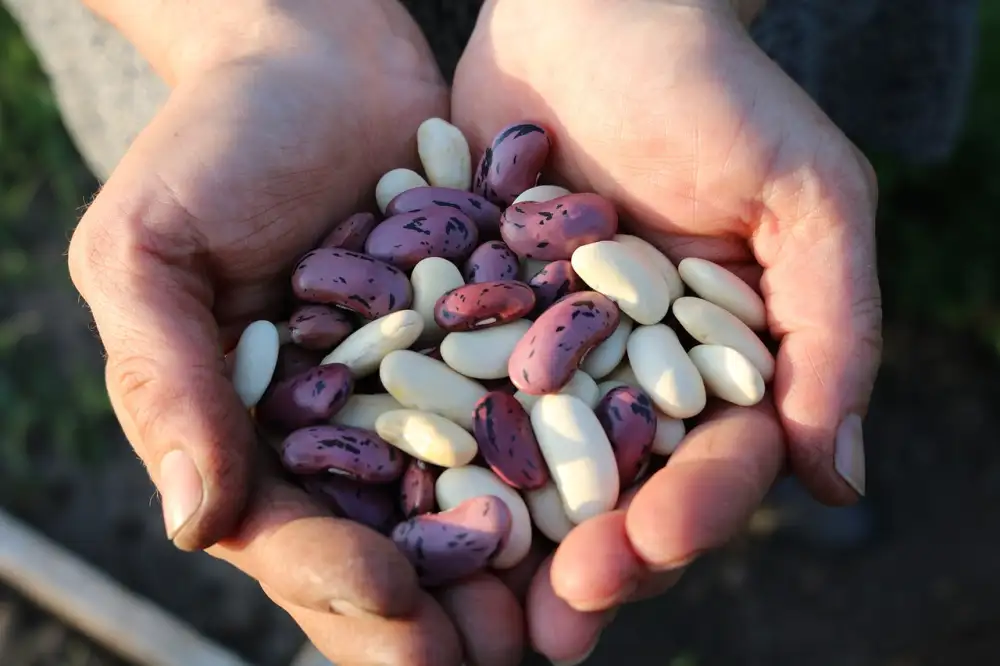Homegrown Delights: Unleashing the Magic of Runner Beans in Your Kitchen

Runner beans, also known as Phaseolus coccineus, are a popular and versatile vegetable that can be easily grown in your home garden. These vibrant green beans are native to Central and South America and have been cultivated for centuries for their delicious taste and nutritional benefits. With their long, slender pods and vibrant red flowers, runner beans add beauty to any garden while providing a bountiful harvest of tasty and nutritious vegetables. Whether you are an experienced gardener or a beginner, growing runner beans is a rewarding experience that will bring joy to your plate.
Health benefits of runner beans
Runner beans are not only a delicious addition to your meals, but they also offer numerous health benefits. Packed with essential nutrients, these vibrant green beans are a great source of dietary fiber, which aids digestion and promotes a healthy gut. They are also rich in vitamins A, C, and K, as well as minerals like iron and potassium. These nutrients contribute to improved immune function, bone health, and overall well-being. Additionally, runner beans contain antioxidants that help fight inflammation and protect against chronic diseases. By incorporating runner beans into your diet, you can enjoy their delightful taste while reaping the many health rewards they have to offer.
Culinary uses of runner beans
Runner beans are a versatile vegetable that can be used in a variety of culinary dishes. They have a unique flavor and texture that adds depth to any meal. One popular way to use runner beans is in salads. Their crispness and vibrant color make them an excellent addition to green salads or pasta salads. They can also be sautéed or stir-fried with other vegetables for a quick and healthy side dish. Runner beans can also be used in soups and stews, adding a hearty element to the dish. Additionally, they can be pickled or preserved for later use, allowing you to enjoy their delicious taste all year round. The possibilities are endless when it comes to incorporating runner beans into your cooking repertoire.
Growing runner beans at home
Growing runner beans at home is a rewarding experience that allows you to enjoy the freshness and flavor of these versatile vegetables. To start, choose a sunny spot in your garden with well-drained soil. Runner beans thrive in warm climates, so make sure to plant them after the last frost.
Prepare the soil by adding organic matter and compost to improve its fertility. Sow the seeds directly into the ground, spacing them about 8 inches apart. Plant them at a depth of 2 inches and provide support for their climbing nature, such as trellises or poles.
Water the plants regularly, keeping the soil moist but not waterlogged. Mulching around the base of the plants helps retain moisture and suppress weeds. As they grow, train the vines onto their supports to encourage upward growth.
Runner beans are heavy feeders, so fertilize them every few weeks with a balanced organic fertilizer. Regularly inspect for pests like aphids or slugs and take appropriate measures to protect your plants.
With proper care and attention, your runner bean plants will flourish and produce an abundant harvest in about 10-12 weeks. Enjoy the satisfaction of growing your own delicious runner beans right in your backyard!
Harvesting and storing runner beans
Harvesting runner beans is an exciting moment for any home gardener. Once the pods are fully developed and have reached a length of about 6 to 8 inches, it's time to pick them. Gently snap the pods off the plant, being careful not to damage the vine.
To ensure a continuous harvest, pick runner beans regularly every few days. Leaving mature pods on the plant can hinder new growth. Remember that overripe pods become tough and lose their flavor.
Storing runner beans is simple. Place them in a perforated plastic bag or wrap them loosely in a damp paper towel before storing in the refrigerator. This will help maintain their freshness and crispness for up to a week.
If you have an abundance of runner beans, consider freezing them for future use. Blanch the beans in boiling water for 2-3 minutes, then transfer them to an ice bath to stop the cooking process. Once cooled, drain and pack them into freezer-safe containers or bags.
By harvesting and storing your homegrown runner beans properly, you can enjoy their delicious taste and nutritional benefits long after the growing season has ended.
Popular recipes featuring runner beans
Popular recipes featuring runner beans include:
1. Runner Bean Salad: Toss blanched runner beans with cherry tomatoes, feta cheese, and a lemon vinaigrette for a refreshing summer salad.
2. Runner Bean Casserole: Combine cooked runner beans with sautéed onions, garlic, and diced tomatoes. Top with breadcrumbs and bake until golden and bubbly.
3. Runner Bean Stir-Fry: Sauté sliced runner beans with garlic, ginger, and soy sauce for a quick and flavorful side dish.
4. Runner Bean Curry: Simmer cooked runner beans in a fragrant curry sauce made from coconut milk, spices, and tomatoes.
5. Runner Bean Soup: Blend cooked runner beans with vegetable broth, onions, carrots, and herbs for a hearty and nutritious soup.
6. Runner Bean Pasta: Toss cooked runner beans with pasta, olive oil, grated Parmesan cheese, and fresh herbs for a simple yet satisfying meal.
7. Runner Bean Frittata: Mix cooked runner beans with beaten eggs, cheese, and herbs. Bake until set for a delicious brunch or light dinner option.
These recipes showcase the versatility of runner beans in various cuisines and are sure to delight your taste buds!
Tips for cooking with runner beans
1. Blanching: Before using runner beans in recipes, blanch them in boiling water for a few minutes to soften their texture and enhance their vibrant color.
2. Stir-frying: Runner beans are perfect for stir-frying as they retain their crunchiness. Cut them into thin strips and toss them in a hot wok with your favorite seasonings and sauces.
3. Steaming: Steaming is a healthy cooking method that preserves the nutrients of runner beans. Steam them until tender-crisp and serve as a side dish or add them to salads.
4. Roasting: Roasting runner beans brings out their natural sweetness and adds a delicious smoky flavor. Toss them with olive oil, salt, and pepper, then roast in the oven until crispy.
5. Pickling: For a tangy twist, pickle runner beans by combining vinegar, sugar, spices, and water in a jar. Let them marinate for a few days before enjoying them as a crunchy snack or adding to sandwiches.
6. Pairing flavors: Runner beans have a mild flavor that pairs well with various ingredients such as garlic, lemon zest, herbs like thyme or basil, bacon, or Parmesan cheese. Experiment with different combinations to discover your favorite flavors.
7. Don't overcook: To maintain the crispness of runner beans, avoid overcooking them. Cook just until they are tender but still retain some bite to ensure maximum flavor and texture.
8. Freezing: If you have an abundance of runner beans from your garden, blanch them quickly and freeze for later use. This way, you can enjoy their freshness even during the off-season.
By following these tips, you can unlock the full potential of runner beans in your culinary creations and savor their unique taste and texture in various dishes.
In conclusion, runner beans are a magical addition to any kitchen. Their vibrant color, crisp texture, and nutty flavor make them a versatile ingredient that can be used in a variety of dishes. From soups and salads to stir-fries and stews, runner beans add a delightful touch to every meal.
Not only do runner beans taste great, but they also offer numerous health benefits. Packed with essential nutrients like fiber, vitamins, and minerals, they promote digestion, boost immunity, and support overall well-being.
Growing runner beans at home is a rewarding experience that allows you to enjoy the freshest produce right from your garden. With proper care and attention, you can cultivate these delicious legumes and savor their flavors throughout the season.
Harvesting and storing runner beans is simple. Just pick them when they are young and tender for optimal taste. Store them in a cool place or blanch and freeze them for future use.
To truly unleash the magic of runner beans in your kitchen, try out popular recipes such as runner bean salad with feta cheese or sautéed runner beans with garlic and lemon zest. These dishes showcase the versatility of this humble vegetable and will surely impress your family and friends.
When cooking with runner beans, remember to blanch them briefly before adding them to your recipes for optimal texture. You can also experiment with different cooking methods such as steaming or roasting to bring out their unique flavors.
So why not embrace the versatility of runner beans at home? Whether you're a seasoned cook or just starting out in the culinary world, these delightful legumes are sure to add a touch of magic to your meals. So go ahead, get creative in the kitchen and let the enchantment of runner beans unfold!
Published: 10. 01. 2024
Category: Home



